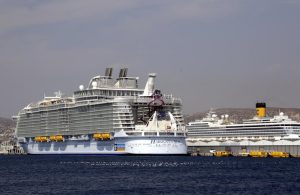
Frédéric Speich for La Provence
French reporters of La Provence have confirmed that an incident occurred aboard the Harmony of the Seas, the world’s largest cruise ship owned by Royal Caribbean Cruise Lines. The ship was docked in French port Marseille when a lifeboat affixed on the 5th deck suddenly detached and fell into the sea, with 5 crew members inside. The newspaper has confirmed one fatality (a 42-year-old Filipino), two critically injured, and two moderately injured. It is still unknown at this time why the lifeboat became detached or why the crew members were in the lifeboat. However some have reported that this incident may have occurred during a security drill taking place while the ship was docked.
Injuries to crew members is unfortunately a common occurrence. In the last decade, the US Department of Transportation disclosed that over 1,300 crew members died in various incidents. That is why it is paramount that crew members and their family know their legal rights when an incident occurs. For each crew member injury claim, there are 3 areas of importance:
- The Jones Act
Crew members who are injured while on the ship have the right to sue their employer or co-workers for their injuries and damages. The main principle and foundation for the rights afforded to crew members and seamen is the fact that an employer has the responsibility and absolute duty to provide a safe working environment to its employees. It also means that safe and adequate equipment must be provided to workers in order to accomplish their daily tasks as safely as possible.
Unlike cruise ship passengers who only have 1 year to file a law suit against the cruise line, seamen have 3 years from the date of injury to file a lawsuit against their employer under the Jones Act. The spectrum of recovery encompasses pain and suffering, medical expenses, and lost earnings.
- Maintenance and Cure
In Maritime law, the obligation of Maintenance requires the owner of the vessel to provide employees with per diem living expenses throughout the crew member’s medical recovery. Once the worker has reached maximum medical improvement status, or once he was declared able to return to work and assume his former duties, the obligation of Maintenance dissipates. The obligation of Cure requires the shipowner to provide the injured seaman with medical care, including medications and medical devices.
- Unseaworthiness Doctrine
Under General maritime law, a shipowner has the recognized duty to provide and furnish a seaworthy ship, which reasonably fits the use of the vessel. Included in this doctrine is the nondeleguable duty to provide adequate safety equipment for the vessel. For example, if a piece of equipment fails, it is sufficient for a crew member to establish the unseaworthiness of ship. If a crew member assaults a fellow worker, the ship may be deemed unseaworthy because of a “defective” crew member. If a dangerous condition aboard the vessel causes or contributes to injuring a worker, a claim against the shipowner for unseaworthiness can be pursued. Under this doctrine, the shipowner cannot claim it was unaware or lacked notice of the dangerous condition as a defense.
Save
 Cruise Ship Lawyers Blog
Cruise Ship Lawyers Blog


